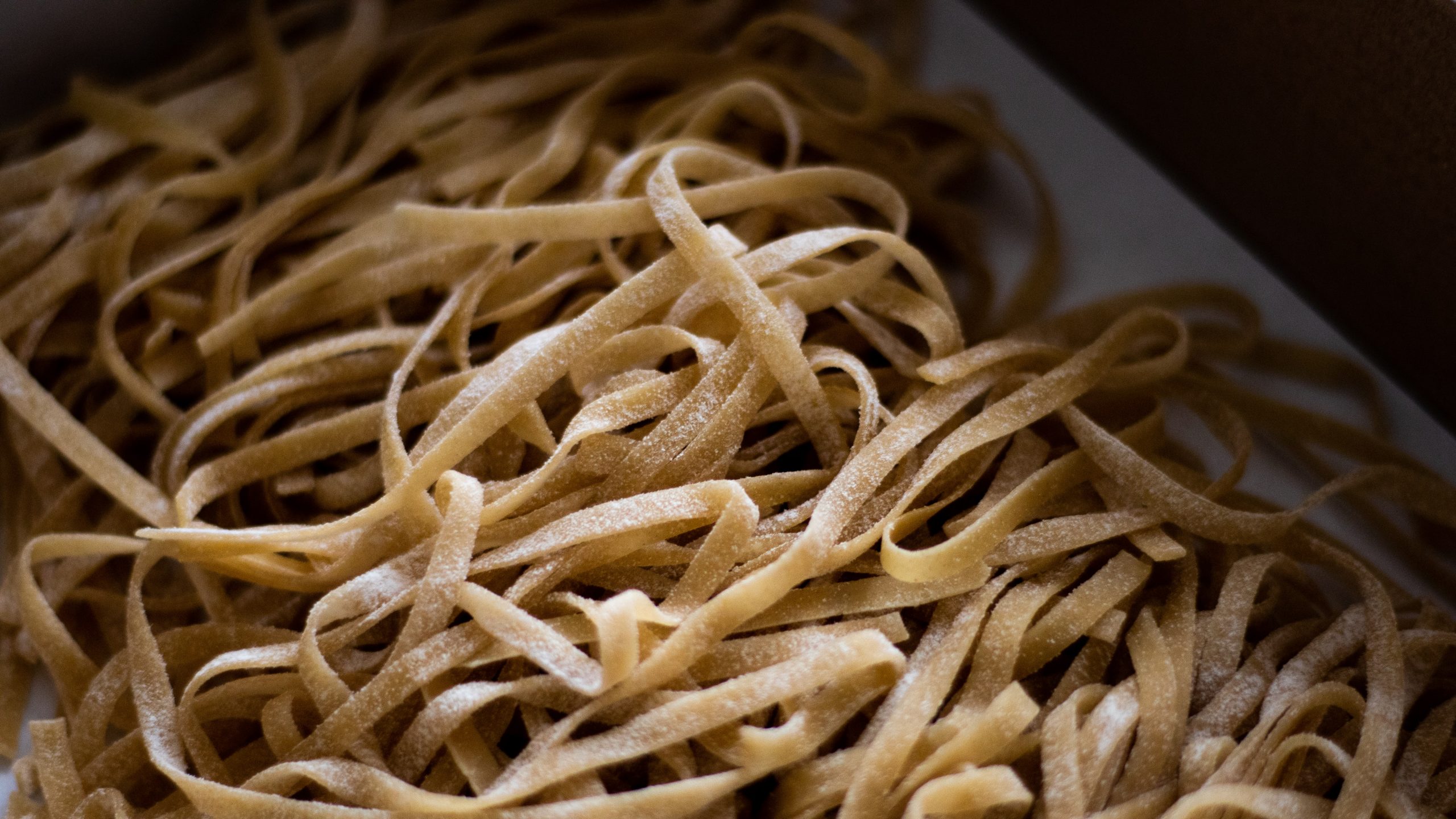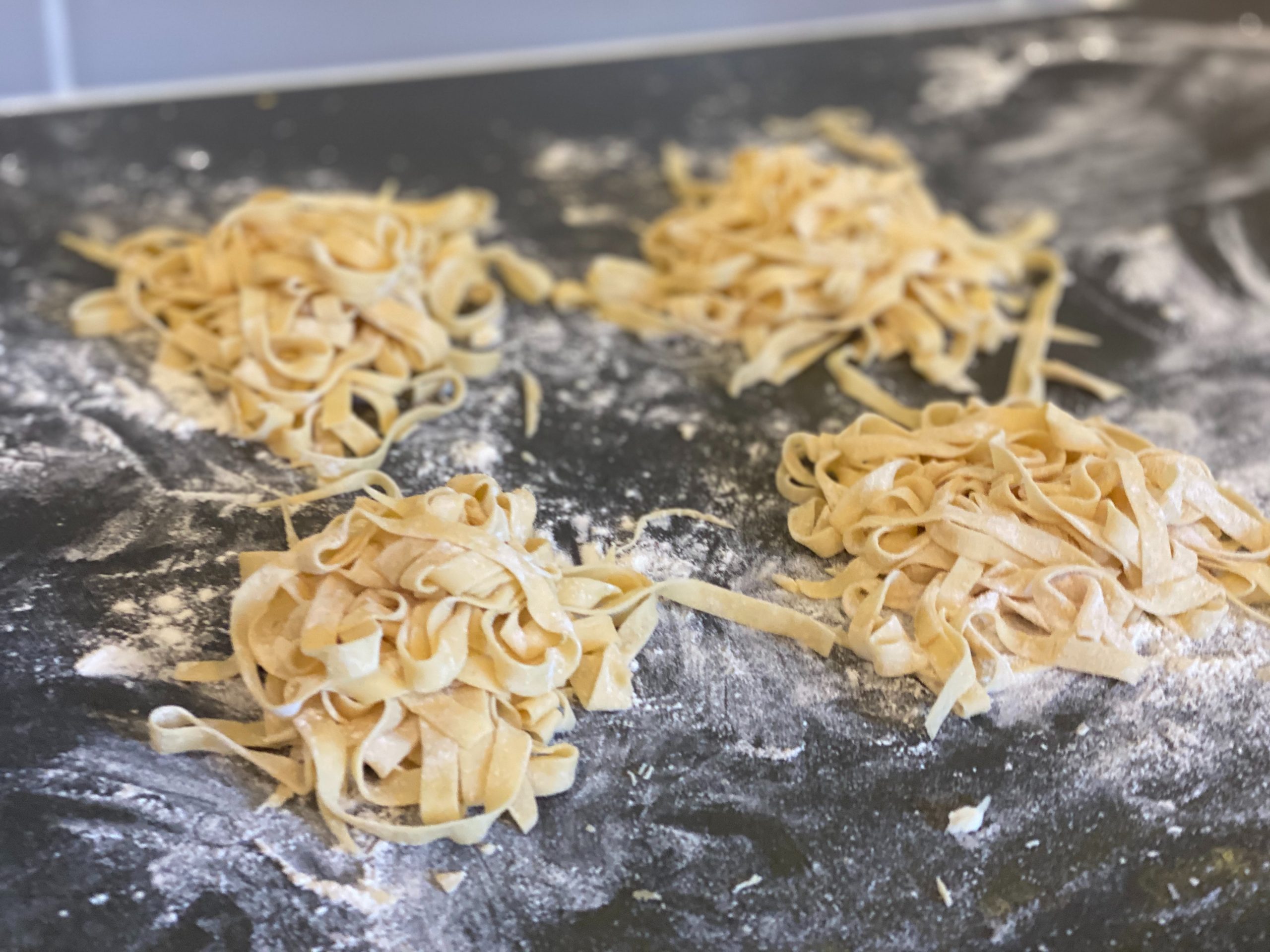Whether making your fresh pasta or buying it ready-made, you’ll want to know how to store it to keep it fresh for as long as possible. It’s a big task, but it’s possible to do. Here are some tips to help you. In this article, you’ll learn all you want to know about how to store fresh pasta, dry fresh pasta, why you have white spots on your fresh pasta, and whether pasta cooked in the sauce can be frozen. You will get important information. Also, you will know how you can tell that fresh pasta has gone bad and what is the shelf life of fresh pasta.

What is Fresh Pasta?
Fresh pasta is formed with dough that is made from flour, eggs, and water. In a stand mixer or pastry blender, pasta cooks combine the ingredients, then knead the dough until it is elastic. The fresh egg pasta is then flattened out with a rolling pin and cut into different shapes with a pasta cutter.
Fresh-cut pasta is not dehydrated, unlike dried spaghetti frequently found in grocery shops. Water should be salted and brought to a boil before cooking pasta. Fresh pasta cooks much faster than dried pasta—just a few minutes instead of up to ten minutes.
How to Store Fresh Pasta?
Whether saving fresh pasta leftovers or cooking them for your next meal, you’ll need to follow a few basic steps to guarantee you get the most out of your purchase. Following these simple guidelines will keep your pasta fresh and tasty. The best place to store pasta is in your refrigerator. Keeping your fridge at a steady temperature of 40 degrees is important.
This will prevent bacteria from growing in your pasta and keep it fresh. A good place to store pasta is in a shallow airtight container with a lid. This is important because the moisture from the pasta can seep out and cause the noodles to become mushy. Alternatively, you can freeze pasta. The shelf life of frozen pasta is much longer than store-bought pasta.
For best results, freeze the pasta in an airtight container. You can also store boiled pasta in the freezer for up to three months. However, you’ll need to defrost the pasta first. To defrost pasta, you’ll need to place it in a small water container. Then, you’ll need to put the pasta into a microwave for about 30 seconds.
Here are a Few Options for Storing Fresh Pasta
Fresh pasta can be preserved in a variety of ways so that you can eat it later. To store and freeze fresh pasta that hasn’t been cooked, follow these instructions:
Put Fresh Pasta in the Fridge:
Whether you’re looking for a way to store pasta for the long haul or you want to have a few extra servings, freezing fresh pasta is a great option. When freezing fresh pasta, you want to freeze it in portions. With just a few basic steps, you can freeze your pasta for future use.
For example, if you’re planning to cook a pasta dish, you should freeze the noodles in one-inch squares, not long noodles. It would help if you also tried to freeze pasta in a container with an airtight seal. This will help protect the pasta from sticking to the container and making a mess. You can choose from a plastic dish, freezer bag, or bottle.
Consider drying your pasta before freezing. Drying your pasta can take up to twelve hours, depending on the humidity and temperature. If you have access to a fan, this can speed up the drying process. Fresh handmade pasta in an airtight container can be held in the fridge for up to a day.
Freeze Freshly Made Pasta Dough:
The dough must be plastic-wrapped and preserved in a ziplock bag or sealed container. The pasta dough can be stored for as long as a month. Before using the dough, thaw it overnight in the refrigerator.
Fresh Pasta Noodles should be Frozen:
Lay the spaghetti noodles on a baking sheet in a single coat after tossing them in some flour to prevent sticking. A circular nest can also be made out of pasta noodles. The semi-dry pasta should be placed in a freezer-safe plastic bag or other airtight containers after the noodles have been allowed to air dry for one hour. For eight months, you can use frozen spaghetti noodles. Frozen noodles can be cooked by plunging them directly into boiling water.
How can Fresh Pasta be Dried?
The main objective of making fresh or dried pasta is to maintain three essential elements in balance. These are the humidity, temperature, and moisture content. The finished product will retain its shape if all three are balanced properly. To achieve this, there are two different methods for drying fresh pasta.
One is by using a dehydrator, and the other is by using an oven. Drying pasta in a dehydrator requires setting a temperature of 135 degrees Fahrenheit. This is the lowest temperature that can be used to dry pasta. It is also the most effective method for preserving pasta.
A dehydrator can be used to dry pasta in a short period. Air is blown over the spaghetti with a fan, and a dehydrator dries it. In addition, you can also use a wire cooling rack to dry the pasta evenly. In the process of drying pasta, the moisture content of the product is reduced from 31-32% to 12-13%.
You must dry fresh pasta noodles if you want to keep them at room temperature for more than a few hours. This lower moisture content prevents the product from spoiling and prevents bacterial growth. These steps can be used to dry fresh pasta sheets or noodles, such as fettuccine or lasagna sheets:
- Add flour to the spaghetti: First, sprinkle the pasta strands with a little flour to prevent sticking before drying new pasta, such as semolina or all-purpose flour.
- Arrange the spaghetti strands: On a baking sheet or a pasta drying rack, spread the fresh pasta strands in a single layer.
- Keep the spaghetti out of direct sunlight: Keep the pasta out of direct sunlight in an unheated oven or on a counter.
- Examine the consistency. You can tell when the pasta snaps rather than twists when you bend it. It will take the pasta between 12 and 24 hours to dry completely.
- Pasta that has just been dried out can be held in the pantry for up to six months.
Why are there White Flecks in my Fresh Pasta?
White dots, more frequently discovered on cooked or fresh pasta, may represent mold. If there are white spots on dry pasta, it may be the result of physical damage. Pasta won’t mold if it’s been kept dry.
What Keeps the Pasta from Needing a Rinse?
In short, washing your cooked pasta would be detrimental to your finished dish because the extra starch is essential for giving the spaghetti sauce you make some structure and flavor. That is the justification for using pasta water in a spaghetti sauce rather than regular tap water.
What is the Shelf Life of Fresh Pasta?
Fresh pasta will begin to soak up water and oxidize if it is kept in the refrigerator for longer than 18 hours. The pasta changing to a “greenish-grey” color is a surefire symptom of this. This is readily mistaken for spaghetti going bad.
Despite what you may think, your spaghetti will still taste amazing if consumed within two days of preparation. Put the servings of fresh pasta in airtight plastic bags before storing them in the fridge. A Tupperware container may also be used, but make sure the seal or lid is secured tightly.
Fresh pasta from the grocery store can be held in the refrigerator for two to three days. This is because it has been previously half-cooked to increase shelf life. However, homemade pasta can only be kept in the refrigerator for 24 hours (though it’s best to consume it within 18 hours).
Can Pasta be Cooked in Sauce and Frozen?
Pasta cooked in sauce is a common leftover food that home cooks freeze. Combine freshly cooked pasta and sauce in freezer bags or other airtight containers for safe storage for up to a month.
Pasta can be divided into individual servings and frozen in individual containers for a great option for a busy lunch. Remove from the freezer to reheat your delicious homemade pasta meal, or store in the refrigerator to thaw overnight.
How do you Tell if Fresh Pasta has Gone Bad?
One of the most obvious indications that pasta has gone bad is when it starts to get slimy or sticky, which typically happens just before mold becomes visibly present. Additionally, you can detect a dullness or discoloration, like a greyish or yellowish tone. You should remove the pasta if it has brown or black particles, white patches, or moldy odors. The same applies if you store it for over five days or if it has an off scent.
Conclusion
Using the right storage method is essential to ensuring the freshness of pasta. To store pasta, choose a clean, dry, airtight container that is not exposed to heat sources. This will help prevent mold and other contaminants from growing on the pasta. The best way to place cooked pasta is to keep it in the refrigerator.
The temperature should be between 33 and 38 degrees Fahrenheit. This will help prevent the growth of bacteria and Salmonella. Fresh pasta should be eaten within two days of purchase. It should also be used before the “use-by” date, which can be on the package.
